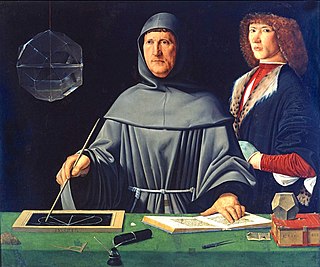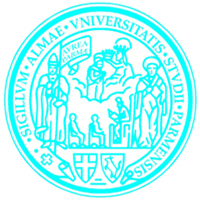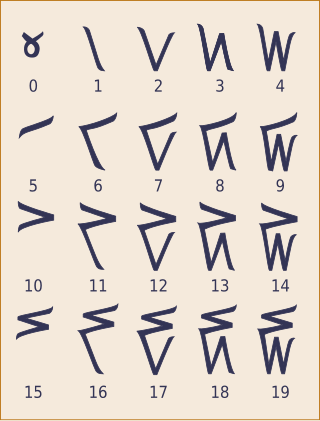Related Research Articles

An abacus, also called a counting frame, is a hand-operated calculating tool which was used from ancient times in the ancient Near East, Europe, China, and Russia, until the adoption of the Hindu-Arabic numeral system. An abacus consists of a two-dimensional array of slidable beads. In their earliest designs, the beads could be loose on a flat surface or sliding in grooves. Later the beads were made to slide on rods and built into a frame, allowing faster manipulation.
The ten Arabic numerals 0, 1, 2, 3, 4, 5, 6, 7, 8, and 9 are the most commonly used symbols for writing numbers. The term often also implies a positional notation using the numerals, as well as the use of a decimal base, in particular when contrasted with other systems such as Roman numerals. However, the symbols are also used to write numbers in other bases such as octal, as well as for writing non-numerical information such as trademarks or license plates identifiers.

The history of mathematics deals with the origin of discoveries in mathematics and the mathematical methods and notation of the past. Before the modern age and the worldwide spread of knowledge, written examples of new mathematical developments have come to light only in a few locales. From 3000 BC the Mesopotamian states of Sumer, Akkad and Assyria, followed closely by Ancient Egypt and the Levantine state of Ebla began using arithmetic, algebra and geometry for purposes of taxation, commerce, trade and also in the patterns in nature, the field of astronomy and to record time and formulate calendars.

Fibonacci, also known as Leonardo Bonacci, Leonardo of Pisa, or Leonardo Bigollo Pisano, was an Italian mathematician from the Republic of Pisa, considered to be "the most talented Western mathematician of the Middle Ages".

Fra. Luca Bartolomeo de Pacioli was an Italian mathematician, Franciscan friar, collaborator with Leonardo da Vinci, and an early contributor to the field now known as accounting. He is referred to as the father of accounting and bookkeeping and he was the first person to publish a work on the double-entry system of book-keeping on the continent. He was also called Luca di Borgo after his birthplace, Borgo Sansepolcro, Tuscany.
0 (zero) is a number representing an empty quantity. Adding 0 to any number leaves that number unchanged. In mathematical terminology, 0 is the additive identity of the integers, rational numbers, real numbers, and complex numbers, as well as other algebraic structures. Multiplying any number by 0 has the result 0, and consequently, division by zero has no meaning in arithmetic.

Liber Abaci is a historic 1202 Latin manuscript on arithmetic by Leonardo of Pisa, posthumously known as Fibonacci.
A numerical digit is a single symbol used alone or in combinations, to represent numbers in a positional numeral system. The name "digit" comes from the fact that the ten digits of the hands correspond to the ten symbols of the common base 10 numeral system, i.e. the decimal digits.

Algorism is the technique of performing basic arithmetic by writing numbers in place value form and applying a set of memorized rules and facts to the digits. One who practices algorism is known as an algorist. This positional notation system has largely superseded earlier calculation systems that used a different set of symbols for each numerical magnitude, such as Roman numerals, and in some cases required a device such as an abacus.

The University of Parma is a public university in Parma, Emilia-Romagna, Italy. It is organised in nine departments. As of 2016 the University of Parma has about 26,000 students.

The Latin school was the grammar school of 14th- to 19th-century Europe, though the latter term was much more common in England. Other terms used include Lateinschule in Germany, or later Gymnasium. Latin schools were also established in Colonial America.
In Italy, the laurea is the main post-secondary academic degree. The name originally referred literally to the laurel wreath, since ancient times a sign of honor and now worn by Italian students right after their official graduation ceremony and sometimes during the graduation party. A graduate is known as a laureato, literally "crowned with laurel."

The Hindu–Arabic numeral system or Indo-Arabic numeral system is a positional base ten numeral system for representing integers; its extension to non-integers is the decimal numeral system, which is presently the most common numeral system.
The Book of Squares, (Liber Quadratorum in the original Latin) is a book on algebra by Leonardo Fibonacci, published in 1225. It was dedicated to Frederick II, Holy Roman Emperor.
After being brought to Pisa by Master Dominick to the feet of your celestial majesty, most glorious prince, Lord F.,

Bern Dibner was an electrical engineer, industrialist, and historian of science and technology. He originated two major US library collections in the history of science and technology.
Europe's achievements in science and technology have been significant and research and development efforts form an integral part of the European economy. Europe has been the home of some of the most prominent researchers in various scientific disciplines, notably physics, mathematics, chemistry and engineering. Scientific research in Europe is supported by industry, by the European universities and by several scientific institutions. All the raw output of scientific research from Europe consistently ranks among the world's best.

The Kaktovik numerals or Kaktovik Iñupiaq numerals are a base-20 system of numerical digits created by Alaskan Iñupiat. They are visually iconic, with shapes that indicate the number being represented.

Mathematics and art are related in a variety of ways. Mathematics has itself been described as an art motivated by beauty. Mathematics can be discerned in arts such as music, dance, painting, architecture, sculpture, and textiles. This article focuses, however, on mathematics in the visual arts.

Henry Wadsworth Gould is a Professor Emeritus of Mathematics at West Virginia University.

Summa de arithmetica, geometria, proportioni et proportionalita is a book on mathematics written by Luca Pacioli and first published in 1494. It contains a comprehensive summary of Renaissance mathematics, including practical arithmetic, basic algebra, basic geometry and accounting, written for use as a textbook and reference work.
References
- Baron, Hans. "The Social Background of Political Liberty in the Early Italian Renaissance". Comparative Studies in Society and History. Vol. 2. No. 4. Cambridge University Press. July 1960. Page 440.
- Fibonacci, Leonardo. "Fibonacci's Liber Abaci: Leonardo Pisano's Book of Calculation". Contributor Laurence Edward Sigler. [1202]. Springer. 2003. Page 4.
- Grendler, Paul F. "Schooling in Renaissance Italy Literacy and Learning, 1300–1600". Baltimore Johns Hopkins University Press. 1989. Pages 2, 5, 19, 12–13, 15–17, 22, 30–31, 33–34, 36, 41, 104.
- Michael of Rhodes Project Team, Dibner Institute, and WGBH Interactive. "Michael of Rhodes: A Medieval Mariner and His Manuscript". Institute and Museum of the History of Science. 2005. Sunday, March 23, 2008.
- Radford, Luis. "On the Epistemological Limits of Language: Mathematical Knowledge and Social Practice During the Renaissance". Educational Studies in Mathematics. Vol. 52. No. 2. Springer. 2003. Pages 127-129, 131.
- Wiesner-Hanks, Merry E. "Early Modern Europe, 1450-1789". Cambridge: Cambridge University Press, 2006. Pages 119-124.
- Yerkes, Robert M. "The Use of Roman Numerals". Science. New series. Vol. 20. No. 505. American Association for the Advancement of Science. September 2, 1904. Pages 309-310.